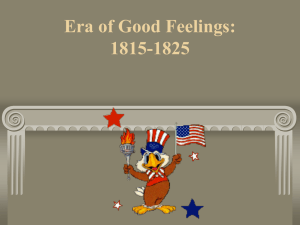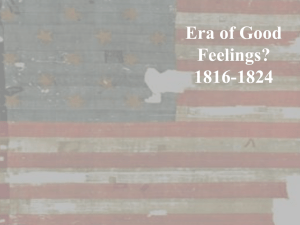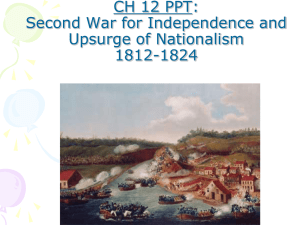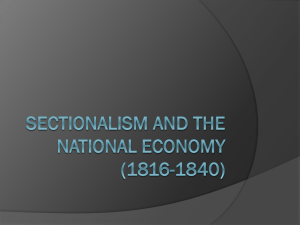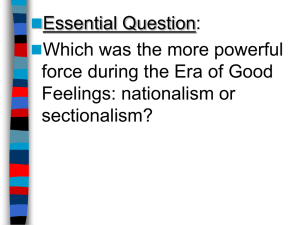president monroe and the era of good feelings
advertisement
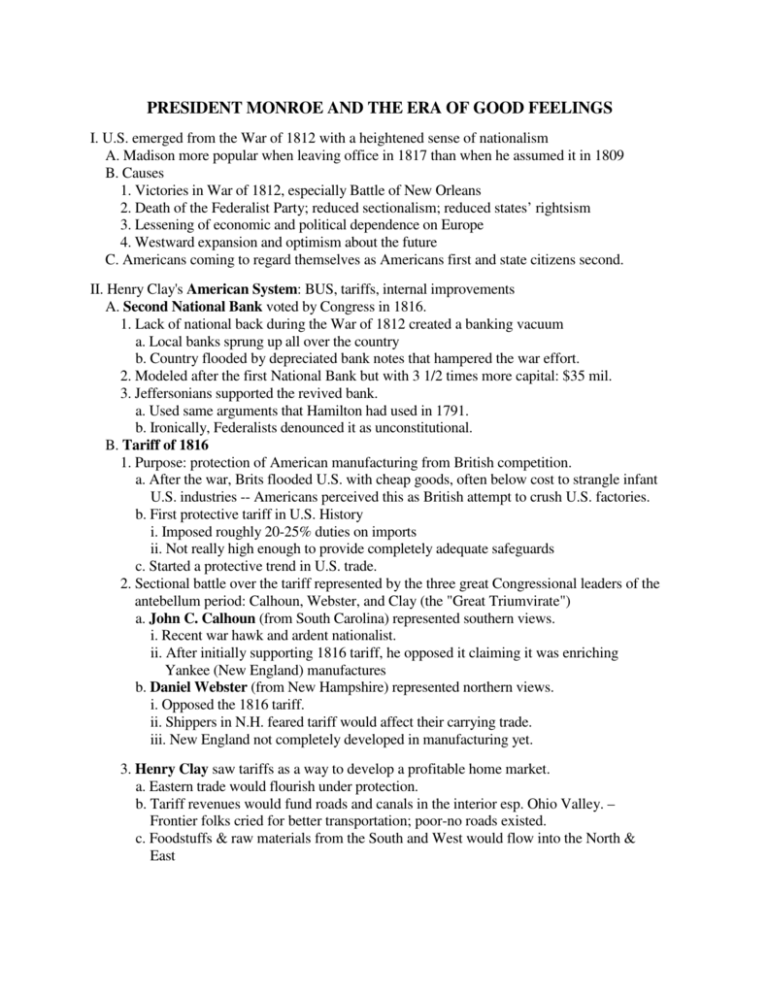
PRESIDENT MONROE AND THE ERA OF GOOD FEELINGS I. U.S. emerged from the War of 1812 with a heightened sense of nationalism A. Madison more popular when leaving office in 1817 than when he assumed it in 1809 B. Causes 1. Victories in War of 1812, especially Battle of New Orleans 2. Death of the Federalist Party; reduced sectionalism; reduced states’ rightsism 3. Lessening of economic and political dependence on Europe 4. Westward expansion and optimism about the future C. Americans coming to regard themselves as Americans first and state citizens second. II. Henry Clay's American System: BUS, tariffs, internal improvements A. Second National Bank voted by Congress in 1816. 1. Lack of national back during the War of 1812 created a banking vacuum a. Local banks sprung up all over the country b. Country flooded by depreciated bank notes that hampered the war effort. 2. Modeled after the first National Bank but with 3 1/2 times more capital: $35 mil. 3. Jeffersonians supported the revived bank. a. Used same arguments that Hamilton had used in 1791. b. Ironically, Federalists denounced it as unconstitutional. B. Tariff of 1816 1. Purpose: protection of American manufacturing from British competition. a. After the war, Brits flooded U.S. with cheap goods, often below cost to strangle infant U.S. industries -- Americans perceived this as British attempt to crush U.S. factories. b. First protective tariff in U.S. History i. Imposed roughly 20-25% duties on imports ii. Not really high enough to provide completely adequate safeguards c. Started a protective trend in U.S. trade. 2. Sectional battle over the tariff represented by the three great Congressional leaders of the antebellum period: Calhoun, Webster, and Clay (the "Great Triumvirate") a. John C. Calhoun (from South Carolina) represented southern views. i. Recent war hawk and ardent nationalist. ii. After initially supporting 1816 tariff, he opposed it claiming it was enriching Yankee (New England) manufactures b. Daniel Webster (from New Hampshire) represented northern views. i. Opposed the 1816 tariff. ii. Shippers in N.H. feared tariff would affect their carrying trade. iii. New England not completely developed in manufacturing yet. 3. Henry Clay saw tariffs as a way to develop a profitable home market. a. Eastern trade would flourish under protection. b. Tariff revenues would fund roads and canals in the interior esp. Ohio Valley. – Frontier folks cried for better transportation; poor-no roads existed. c. Foodstuffs & raw materials from the South and West would flow into the North & East C. Internal Improvements (failure) 1. Congress passed Calhoun's Bonus Bill in 1817; would have given $1.5 million to states for internal improvements. a. Madison vetoed it claiming it was unconstitutional b. His successor, James Monroe, followed suit. c. Jeffersonians hated idea of direct federal support of intrastate internal improvements; saw it as a states’ rights issue d. New England opposed federally constructed roads & canals; would drain away population and create competing states in the West. 2. Prior to Civil War, most internal improvements (except railroads) were done at the expense of state and local governments. -- For example, Erie Canal in New York. III. Era of Good Feelings (1817-1825) A. James Monroe elected President in 1816 1. Continued the Virginia dynasty (4 of 5 initial presidents Virginian; 32 of first 36 yrs) 2. Death of Federalist party resulted after the election. a. Federalist liabilities i. "Disloyalty" during the Wr of 1812 ii. Became extremely sectional (interests of New England) and unable to accept new nationalistic program iii. Jefferson had adopted many of their most important ideas (e.g. Hamilton’s financial plan, expansion, loose construction in certain cases) b. Ironically, Federalists reversed many of their initial positions i. Originally nationalistic; now opposed to Republican nationalism ii. Many became strict constructionists esp. vis-à-vis internal improve B. "Era of Good Feelings" moniker somewhat of a misnomer: Acute issues troubled the country. 1. Crystallizing sectionalism (east, west and south) 2. Tariff issue (east and south opposed; west in favor) 3. Internal improvements (east and south opposed; west in favor) 4. Bank of U.S. (BUS) (west and south opposed; eastern bankers in favor) 5. Sale of public lands (east opposed; west and south in favor) 6. Republican Party enjoying 1-party rule began developing factions eventually leading to 2nd Party System in the 1830s -- Clay, Calhoun, Jackson, John Quincy.Adams C. Monroe's presidency oversaw two major events: 1. Panic of 1819 2. Missouri Compromise of 1820 IV. Panic of 1819 A. Economic panic and depression set in 1819 1. First financial panic since the "Critical Period" of the 1780s under Articles of Confederation. -- Henceforth, panics and depressions would occur approximately every 20 years. 2. Causes of 1819 panic: a. Most immediate cause: Over-speculation on frontier lands by banks (especially BUS) b. Inflation from 1812 war + economic drop-off after war (especially cotton) = vulnerable economy c. Significant deficit in balance of trade with Britain = U.S. drained of vital specie d. BUS forced "wildcat" western banks to foreclose on western farms -- BUS stopped allowing payment in paper; now demanded payment in specie; state banks affected & called in loans in specie; farmers didn’t have specie 3. Resulted in calls for reform and pressure for increased democracy. a. Western farmers viewed the bank as an evil financial monster. b. Hard hit poor classes looking for more responsive gov't (beginnings of Jacksonian democracy) c. New land legislation resulted in smaller parcels being sold for lower prices. -By the Civil War, western land would be given nearly for free. d. Directed attention to inhumanity of imprisoning debtors -- some states passed remedial legislation. B. Monroe reelected in 1820 with all but one electoral vote (nearly unanimous) -- Only president in history to be elected after a major panic. V. The Growing West A. New states' characteristics 1. No long-established history of states' rights 2. More than other regions, depended on federal gov't where it had secured most of its land. 3. Melting pot of a wide diversity of peoples immigrating from the east. B. 9 frontier states joined the union between 1791 & 1819 1. Most had been admitted alternately free and slave. 2. Maintaining a sectional balance in Congress was a supreme goal. C. Reasons for explosive westward expansion 1. Westward movement had been significant since colonial era. 2. Cheap lands in the Ohio territory attracted large numbers of European immigrants. 3. Land exhaustion in older tobacco states drove people westward. 4. Speculators accepted small down payments & made purchase of land easier. 5. Economic distress of embargo years stimulated migration west. 6. Crushing of Indians during the war cleared much of the frontier. a. Battle of Fallen Timbers (1794) and Jay Treaty b. Battle of Tippecanoe (1811) 7. Transportation Revolution improved land routes to Ohio Valley. a. Cumberland Road built in 1811; ran from MD to Illinois. b. Emergence of the steamboat in 1811 made upstream travel possible. c. Canals beginning in 1826 allowed for increased trade between west and east. D. West still remained weak in population and influence 1. Forced to ally itself with other sections when addressing national political issues. 2. Demanded land reform & cheap transportation (got it slowly), cheap money and issued its own "wildcat" banks, & fought the powerful Bank of the US to get its goals VI. Missouri Compromise of 1820 A. Missouri asked Congress to enter the union in 1819 1. Tallmadge Amendment passed by the House of Representatives in response. a. No more slaves could be brought into Missouri b. Gradual emancipation of children born to slave parents already there. B. Southern states viewed Tallmadge Amendment as ominous threat to sectional balance. 1. Jefferson: The crisis rang as "a firebell in the night." 2. Concerned by fast increase in northern population and economy and political balance in in the House of Representatives. -- Senate still balanced 11 free to 11 slave states; parity had to be maintained 3. Future of the slave system caused southerners profound concern. a. Missouri first state entirely west of the Mississippi made from the Louisiana Territory. b. Tallmadge amendment might set a precedent for the rest of the area to be free. c. If Congress could abolish slavery in Missouri, it might try in southern states. d. Small group of antislavery agitators in the North used the occasion to protest 4. The Senate refused to pass the amendment and as the crisis loomed C. Missouri Compromise of 1820 1. Henry Clay played a key role in mediating a compromise 2. Provisions: a. Congress agreed to admit Missouri as a slave state. b. Maine was admitted as a free-soil state -- Balance kept at 12 to 12 for the next 15 years. c. Future slavery prohibited north of 36-30' line, the southern border of Missouri. -- Ironically, Missouri was north of the 36-30 line. 3. Compromise was largely accepted by both sides a. South got Missouri b. North won concession that it could forbid slavery in the remaining territories above 36-30 line i. Northern advantage because Spanish territory in southwest prevented significant southern expansion westward. ii. Southerners not overly concerned of lands north of 36-30 as lands not conducive to slave-labor cash crop agriculture. D. Legacy of the Compromise 1. Lasted 34 years and preserved the union (until the Kansas-Nebraska Act in 1854) 2. Henceforth, slavery became a dominant issue in American politics. -- serious setback to national unity 3. South began to develop a sectional nationalism of its own. -- looked to the young West who was seeking allies as well. 4. Clay criticized by subsequent generations as an "appeaser" a. Yet, nation was founded on compromise; no one section could dominate b. End of compromise in the 1850s resulted in civil war.
